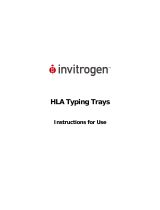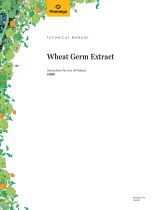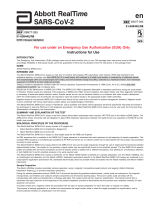Page is loading ...

Table 1. Contents and storage information.
Material Amount Storage Stability
Reactive Oxygen Species (ROS) Detection reagents See label
≤–20°C
Desiccate
Protect from light
Protect from air *
Avoid freeze-thaw cycles
•
•
•
•
•
When stored as directed, this
product is stable for at least
3 months.
* These products are air sensitive and should be stored under dry argon or nitrogen.
Approximate Fluorescence Excitation and Emission, in nm : 492–495/517–527, in nm.
Reactive Oxygen Species (ROS) Detection Reagents
Introduction
Molecular Probes offers derivatives of reduced fluorescein and calcein as cell-permeant
indicators for reactive oxygen species. Chemically reduced and acetylated forms of 2′,7′-di-
chlorofluorescein (DCF) and calcein are nonfluorescent until the acetate groups are removed
by intracellular esterases and oxidation occurs within the cell 1–4 (Figures 1 and 2). Esterase
cleavage of the lipophilic blocking groups yields a charged form of the dye that is much better
retained by cells than is the parent compound. Oxidation of these probes can be detected by
monitoring the increase in fluorescence with a flow cytometer, fluorometer, microplate reader,
or fluorescence microscope, using excitation sources and filters appropriate for fluorescein
(FITC).5–8 Because the dyes are susceptible to photo-oxidation, low light conditions should
be used for fluorescence microscopy applications whenever possible.9
The carboxy derivative of fluorescein, carboxy-H2DCFDA (C400), carries additional negative
charges that improve its retention compared to noncarboxylated forms. The fluorinated
derivative, H2DFFDA (C13293), exhibits improved photostability compared to chlorinated
fluorescein derivatives. Derivatives with a thiol-reactive chloromethyl group (C6827) or an
amine-reactive succinimidyl ester group (D2935) allow for covalent binding to intracellular
components, permitting even longer retention within the cell. H2DCFDA, SE (D2935) may
also provide extracellular labeling.
Dihydrocalcein, AM is freely permeant to cell membranes and is oxidized to green-fluorescent
calcein, which has excellent retention properties. However, unlike the fluorescein derivatives,
calcein fluorescence can be quenched by Fe3+, Co2+, Ni2+, and Cu2+ at pH 7. Other reduced
fluorescein ROS indicators available from Molecular Probes include aminophenyl fluorescein
(A36003) and hydroxyphenyl fluorescein (H36004).
Revised: 10–January–2006 | MP 36103

Reactive Oxygen Species (ROS) Detection Reagents | 2
Guidelines for Use
Materials Required but
Not Provided DMSO
DMF
Ethanol
Buffer, such as PBS, HBSS, or HEPES
Preparing the Stock Solutions Do not dissolve products until immediately prior to use. Acetylated dyes should be
reconstituted only as required using high quality anhydrous dimethylsulfoxide (DMSO),
dimethylform-amide (DMF), or 100% ethanol. Working solutions should be freshly prepared;
discard excess diluted probe at the end of the work session. These probes oxidize more read-
ily in solution, and the presence of moisture will facilitate the decomposition of the dye.
General Considerations Protocols for loading a particular dye and/or cell type can be found in the literature. The AM
or acetate ester concentration should be kept as low as possible to reduce potential artifacts
from overloading, including incomplete hydrolysis, compartmentalization, and the toxic
effects of hydrolysis by-products (e.g., formaldehyde, acetic acid). Loading may be done at
the optimal temperature for cell growth; however, some investigators have reported a greater
degree of compartmentalization at physiological temperatures than is observed at room
temperature.
•
•
•
•
Figure 1. Absorption spectrum of reduced dye (---) and absorption/emission spectra of oxidized dye (—).
Figure 2. The structures of (a) H2DCFDA, (b) carboxy-H2DCFDA, (c) chloromethyl-H2DCFDA, (d) deacetylated H2DCF, and
(e) the deacetylated, oxidized product, DCF.

Reactive Oxygen Species (ROS) Detection Reagents | 3
To determine the optimal dye-loading concentration, temperature, incubation, recovery, and
retention time for your specific application, we recommend using a cell-permeant oxidized
form of the ROS indicator such as carboxy-DCFDA (C369), fluorescein diacetate (F1303), or
calcein, AM (C1430).
Extracellular hydrolysis of the AM and acetate esters can be minimized by using a loading
buffer that is free of primary and secondary amines (such as PBS). Cells should be maintained
in medium that is free of phenol red and other colorimetric dyes prior to and throughout the
assay and washed with dye-free buffer or media after loading.
Note: The time the dye is retained within the cells must cover the duration of the experiment.
Cells vary in their response to dyes; some dyes are lost by passive diffusion over time, or more
quickly by active efflux. If the assay is to be carried over an extended period of time, dye-
retention times need to be determined beforehand. This should also be done for derivatives
that allow for covalent attachment, since cells vary in the rates at which they turn over various
cellular components, and in their viability subsequent to covalent modification.
Protocols The following protocols provide general guidelines derived from various publications, and
should be modified for the particular application and sensitivity required.
1.1 Shortly before performing the experiments, reconstitute the ROS indicator to make a concen-
trated stock solution. Keep tightly sealed until ready to use.
1.2 Remove cells from growth media via centrifugation or pipetting. Resuspend cells in pre-
warmed buffer (PBS, HBSS, HEPES, or other simple physiological buffer) containing the
probe to provide a final working concentration of ~1–10 mM dye. The optimal working
concentration for your application must be empirically determined.
1.3 Incubate at the optimal temperature for the cells. Generally, a loading time of 5–60 minutes
is sufficient.
1.4 Remove the loading buffer; return the cells to prewarmed growth medium and incubate at
the optimal temperature. For derivatives with acetoxymethyl ester (AM) and/or diacetate
groups, allow a short recovery time for cellular esterases to hydrolyze the AM or acetate
groups and render the dye responsive to oxidation. The optimal recovery time can vary
widely, as some cell types normally exhibit low levels of esterase activity.10
1.5 Determine the baseline fluorescence intensity of a sample of the loaded cells prior to exposing
the cells to experimental inducements. If using the succinimidyl ester derivative (C2935), any
extracellularly bound dye can be quenched using Trypan Blue (~0.0025% w/v) in order to
better distinguish the signal from the intracellular ROS response.
1.6 Negative controls should be assessed as follows:
a) Examine unstained cells for autofluorescence in the green emission range.
b) For flow cytometry, ascertain that the forward and side scatter of cells is unchanged after
dye-loading and treatment. Changes in cell dimensions may be related to blebbing or shrink-
age resulting from handling or a toxic response.
c) Examine the fluorescence of cell-free mixtures of dye and buffer/media with and without
the inducer/stimulant. In the absence of extracellular esterases and other oxidative enzymes,
the ROS indicator should exhibit a gradual increase in fluorescence over time, which may be re-
lated to spontaneous hydrolysis, atmospheric oxidation, and/or light-induced oxidation.11–13
d) Examine the fluorescence of untreated loaded cells that have been maintained in growth
medium or simple buffer. In healthy cells, oxygen radicals are eliminated by cellular enzymes
and/or natural antioxidants. Following the dye-loading recovery period, healthy cells should
exhibit a low level of fluorescence that is relatively stable for the duration of the experiment;

Reactive Oxygen Species (ROS) Detection Reagents | 4
however, a gradual increase (due to auto-oxidation) or decrease (due to loss of dye from
cells or photobleaching) in fluorescence may be observed. In the absence of any stimulus or
inducement, a burst of fluorescence in healthy, untreated cells could indicate progress to cell
death or some other oxidative event.
1.7 To create positive controls, oxidative activity may be stimulated with:
a) the tumor promoter 4b-phorbol 12-myristate 13-acetate (PMA; stock solution 1 mM in
DMF; working concentration 100 pM to 10 mM)
b) the bacterial chemotatic peptide N-formyl--methionyl--leucyl--phenylalanine (fMLP;
stock solution 1 mM in DMF; working concentration 1–10 mM)
c) H2O2 or tert-butyl hydroperoxide (TBHP) to a final concentration of ~100 mM (increase or
decrease based on the sensitivity and response of the cells).
1.8 To assure that an added drug or compound will not quench the dye, examine the absorbance
spectrum of the compound and determine that the absorbance peak does not overlap with
either the excitation or emission peak of the oxidized dye. Alternatively, you can mix a solu-
tion of the drug/compound with carboxy-DCF (C368), fluorescein (F1300), or calcein (C481),
then compare the fluorescence intensity to a control solution of the dye, or subject a culture
loaded with the cell-permeant, oxidized form of the dye to the drug/compound and compare
to dye-loaded cells untreated.
References
1. Anal Biochem 11, 6 (1965); 2. Anal Biochem 11, 1 (1965); 3. Anal Biochem 134, 111 (1983); 4. Cell Biol Int 24, 757 (2000); 5. J Immunol Methods
156, 39 (1992); 6. J Immunol Methods 178, 89 (1995); 7. Toxicol in Vitro 11, 531 (1997); 8. J Histochem Cytochem 50, 289 (2002); 9. Biochem Bio-
phys Res Commun 304, 619 (2003); 10. J Leukoc Biol 43, 304 (1988); 11. FEBS Lett 511, 21 (2002); 12. Free Radic Biol Med 33, 938 (2002); 13. Free
Radic Biol Med 30, 1418 (2001).
Product List Current prices may be obtained from our website or from our Customer Service Department.
Cat # Product Name Unit Size
C13293 5-(and-6)-carboxy-2′,7′-difluorodihydrofluorescein diacetate (carboxy-H2DFFDA) *mixed isomers* . . . . . . . . . . . . . . . . . . . . . . . . . . . . . . . 5 mg
C400 5-(and-6)-carboxy-2′,7′-dichlorodihydrofluorescein diacetate (carboxy-H2DCFDA) *mixed isomers* . . . . . . . . . . . . . . . . . . . . . . . . . . . . . . . 25 mg
C6827 5-(and-6)-chloromethyl-2′,7′-dichlorodihydrofluorescein diacetate, acetyl ester (CM-H2DCFDA) *mixed isomers*
*special packaging*............................................................................................................. 20 x 50 µg
D23805 dihydrocalcein, AM *special packaging*......................................................................................... 20 x 50 µg
D2935 2′,7′-dichlorodihydrofluorescein diacetate, succinimidyl ester (OxyBURST® Green H2DCFDA, SE) ................................... 5 mg
D399 2′,7′-dichlorodihydrofluorescein diacetate (2′,7′-dichlorofluorescin diacetate; H2DCFDA).......................................... 100 mg
C2938 6-carboxy-2′,7′-dichlorodihydrofluoresce in diacetate, di(acetoxymethyl ester). . . . . . . . . . . . . . . . . . . . . . . . . . . . . . . . . . . . . . . . . . . . . . . . . . . . 5 mg

Reactive Oxygen Species (ROS) Detection Reagents | 5
Contact Information
Molecular Probes, Inc.
29851 Willow Creek Road
Eugene, OR 97402
Phone: (541) 465-8300
Fax: (541) 335-0504
Customer Service:
6:00 am to 4:30 pm (Pacific Time)
Phone: (541) 335-0338
Fax: (541) 335-0305
probesorder@invitrogen.com
Toll-Free Ordering for USA:
Order Phone: (800) 438-2209
Order Fax: (800) 438-0228
Technical Service:
8:00 am to 4:00 pm (Pacific Time)
Phone: (541) 335-0353
Toll-Free (800) 438-2209
Fax: (541) 335-0238
probestech@invitrogen.com
Invitrogen European Headquarters
Invitrogen, Ltd.
3 Fountain Drive
Inchinnan Business Park
Paisley PA4 9RF, UK
Phone: +44 (0) 141 814 6100
Fax: +44 (0) 141 814 6260
Email: euroinfo@invitrogen.com
Technical Services: eurotech@invitrogen.com
Further information on Molecular Probes products, including product bibliographies, is available from your local distributor or directly
from Molecular Probes. Customers in Europe, Africa and the Middle East should contact our office in Paisley, United Kingdom. All others
should contact our Technical Assistance Department in Eugene, Oregon.
Molecular Probes products are high-quality reagents and materials intended for research purposes only. These products must be used
by, or directly under the supervision of, a technically qualified individual experienced in handling potentially hazardous chemicals. Please
read the Material Safety Data Sheet provided for each product; other regulatory considerations may apply.
Limited Use Label License No. 223: Labeling and Detection Technology
The purchase of this product conveys to the buyer the non-transferable right to use the purchased amount of the product and compo-
nents of the product in research conducted by the buyer (whether the buyer is an academic or for-profit entity). The buyer cannot sell or
otherwise transfer (a) this product (b) its components or (c) materials made using this product or its components to a third party or oth-
erwise use this product or its components or materials made using this product or its components for Commercial Purposes. The buyer
may transfer information or materials made through the use of this product to a scientific collaborator, provided that such transfer is not
for any Commercial Purpose, and that such collaborator agrees in writing (a) to not transfer such materials to any third party, and (b) to
use such transferred materials and/or information solely for research and not for Commercial Purposes. Commercial Purposes means any
activity by a party for consideration and may include, but is not limited to: (1) use of the product or its components in manufacturing; (2)
use of the product or its components to provide a service, information, or data; (3) use of the product or its components for therapeutic,
diagnostic or prophylactic purposes; or (4) resale of the product or its components, whether or not such product or its components are
resold for use in research. Invitrogen Corporation will not assert a claim against the buyer of infringement of the above patents based
upon the manufacture, use or sale of a therapeutic, clinical diagnostic, vaccine or prophylactic product developed in research by the
buyer in which this product or its components was employed, provided that neither this product nor any of its components was used
in the manufacture of such product. If the purchaser is not willing to accept the limitations of this limited use statement, Invitrogen is
willing to accept return of the product with a full refund. For information on purchasing a license to this product for purposes other than
research, contact Molecular Probes, Inc., Business Development, 29851 Willow Creek Road, Eugene, OR 97402, Tel: (541) 465-8300. Fax:
(541) 335-0354.
Several Molecular Probes products and product applications are covered by U.S. and foreign patents and patents pending. All names con-
taining the designation ® are registered with the U.S. Patent and Trademark Office.
Copyright 2006, Molecular Probes, Inc. All rights reserved. This information is subject to change without notice.
/












